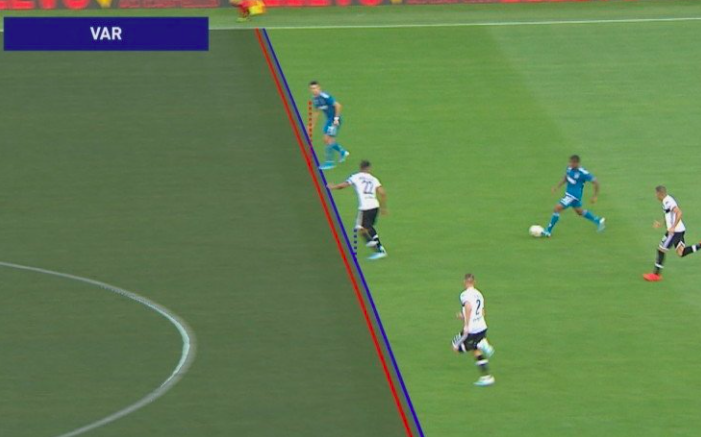
Offside in Soccer/Football: meaning, rules, explanation in simple terms
Novembre 2, 2022Many football fans, and not only, want to know what offside is and how it works in football. In this article we offer a complete overview of the offside rule, the most discussed and complicated rule in the game of football. In addition to offering the simple explanation of the offside rule, we will deepen the discussion by explaining everything in detail: from the passive offside to the return offside, from when it was born to how the offside on rejected by the goalkeeper works. In football, offside is one of the most talked about rules.
 |  |
I contenuti della pagina
How does the offside work?
The offside rule, active or passive, is one of the most difficult to understand and explain in the rules of football. A football match is often characterized by offside episodes. The infringement is very common but many fans try to understand how offside works in football. In this article you will find everything you need to know about offside: the differences between active offside and passive offside, who invented the rule and the evolution of the regulation, and also the explanation of the return offside. Here you will find all the information on offside: from the regulation of passive offside to that of the goalkeeper rejected, from the return offside to that after a deflection by a defender or on a back pass. We also explain when it is not offside.
The offside rule in football
According to FIFA rules, a player is in an offside position if he is closer to the attacking goal line than the opponents when his teammate passes. In short, a player is in an offside position if, at the moment of the touch of the ball in the passage of his teammate, he is beyond the defensive line of the opposing team. The offside is signaled by the linesman, who raises the flag to signal the offside. The game is then resumed with an indirect free kick in favor of the defending team, which is beaten at the point of the offside position.
What is the offside rule in simple terms?
The offside rule is perhaps one of the hardest rules to understand in football, mainly because it is never described in a simple way, so understanding it can be difficult. Many fans look for a simple explanation to explain the offside rule in football to the less experienced. Does your girlfriend or wife ask you what offside is and how does it work in football? In this paragraph we provide a simple explanation that can help you. Here is a simple guide to explain the offside rule as clearly as possible! If we could summarize the rule in one small sentence, it would be this: offside occurs when a player goes behind the opposing defenders’ line before the ball has been passed to him. Of course, there are a lot more elements to the rule, but this is a good place to start. There are three conditions that must be met before a player is classified as offside, so it may be worth writing them on a board: the player must be in the opposing half of the playing field, the attacking player must be closer to the line of play. goal of any defending player, the attacking player must be “in play”, so he either plays the ball or interferes with the goalkeeper.
What are the exceptions where offsides will not be called?
A player is not in an offside position if:
- He starts from his half of the playing field.
- No part of the player’s body (head, body or feet) is closer to the opponent’s goal than the final defender (except the goalkeeper).
- He is receiving the ball from a lineout, a goal kick or a corner kick
- It is behind the ball line
What is passive offsides in soccer?
Passive offside is a variant of offside. What does passive offside mean? It means that it is not active and therefore not punishable by the referee. In what situations is offside passive? When there is no interference between the offside player and the game action. The attacking player must attempt to play the ball to be called offside. Passive offside in football occurs when an attacking player is in an offside position but is not attempting to play the ball or get involved in the game. When the player goes back or stands still, without interfering with the game. This is called the football passive offside rule and the game will not be interrupted. Before seeing when it is passive offside, it is better to specify a particular case of offside. In the passive offside rule it is important to know that if a player makes an intentional play, he puts the opponent who was in the offside position back into play. A player in an offside position who receives the ball from an opponent, who plays it deliberately (except on an intentional save or save of a goal), in fact, is no longer offside.
When it is passive offside
- When it does not obstruct the line of vision of the ball to defenders and goalie.
- When he is not interested in the ball and does not compete for it with his opponents.
- When he does not clearly try to play the ball after returning it to an opponent.
- When he does not make gestures that have an obvious influence on an opponent’s ability to play the ball freely.
- When he does not take advantage of the offside position after a rebound on a player or a wood in the goal.
Offside on rejected by the goalkeeper: regulation
Let’s take an example of a very particular episode relating to the offside rule on rejected by the goalkeeper. An attacker crosses towards the opponent’s goal area in which there are the goalkeeper and an attacker in an offside position “not punishable” as he is at a distance from the goalkeeper himself and from other defenders and does not interfere with anyone. The goalkeeper comes out in high grip and takes possession of the ball with both hands, giving a clear idea of being in control. On falling back to the ground, however, he loses control of the ball which goes to the opposing player offside and scores. Is it offside or not? The discriminant: if the ball thrown by the attacker is to be considered a shot on goal, which in the absence of the goalkeeper’s intervention would have entered the net, then the attacker who takes possession of the ball is offside punishable because the loss of the ball after an aerial catch it is similar to the goalkeeper’s rebound, and therefore to a “save”. The situation is different if the attacker’s throw is to be considered a Cross: in this case the goalkeeper’s loss of the ball is a voluntary play and, therefore, the position of the attacker who takes possession of the ball is remedied.
History of the offside: when it was born and who invented it
Here is the story of the offside in football
1859: first definition of the rule in the Sheffield Rules
1863: governed by the IFAB Regulations
1864: there had to be 4 opponents between the player receiving the ball and the opponent’s goal.
1866: the number of opponents drops from 4 to 3
1907: he is offside only in the opposing half of the pitch
1924: introduction of passive offside
1926: it goes from 3 to 2 opponents
2004/05: arms and hands are excluded
2010: abolished the rule of “light” between bodies
Who invented the offside?
As Wikipedia reports, “the first definition of the offside rule is dated 1859 and reported in the Sheffield Rules, which is the first draft of football regulations conceived by Nathaniel Creswick and William Prest and defined to regulate the matches of the English region of Sheffield and the Midlands”.
What is offside in football: the new rules
The main novelty of the new offside rules in football is represented by the fact that the deflection of the defender puts the attacker who is beyond the line of the ball back into play. Any voluntary, deliberate act by the defender in an attempt to catch the ball, subject to a defined list of exceptions, puts the attacker back into play, regardless of how the play is concluded.
The touch of the defender puts the attacker back into play, except when:
- the attacker is not less than one and a half meters from the defender;
- the attacking player does not contest the ball against the defender;
- the deflection of the defender is not a ‘deliberate save’ (an action aimed at avoiding the goal such as a save on the line or a push by the goalkeeper)
Offside, a matter of millimeters? Play
By regulation, the attacker’s position must be analyzed at the exact moment when the passer comes into contact with the ball. However, it has long been realized that the TV does not always allow you to choose the exact frame. Sometimes in the frame selected in the Var room, the sphere is still attached to the foot, but the passage has already begun. The Ifab would have introduced “tolerance” for offside cases at the limit and restored more power to the linesmen. The reference is to cases in which the offside is millimeter, in which the tip of a shoe beyond the line of the defenders is enough to cancel a goal. As Secretary General Lukas Brud explained: “In theory an offside of one millimeter is offside, but if the first decision is not to whistle it and then the Var must use 12 cameras, it means that it was not a clear and obvious mistake”. In short, in cases of millimeter offside, the Var could do little: the decision is not very clear and the decision will remain that of the linesman.





